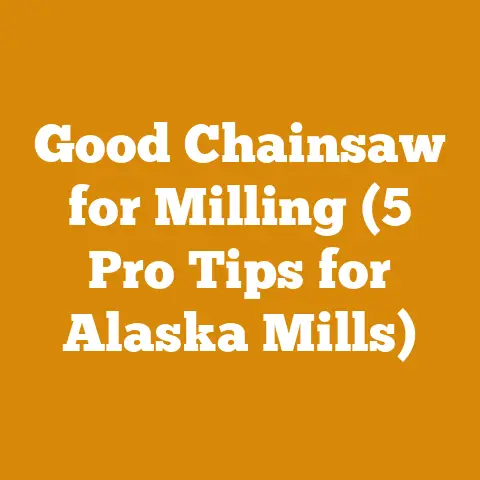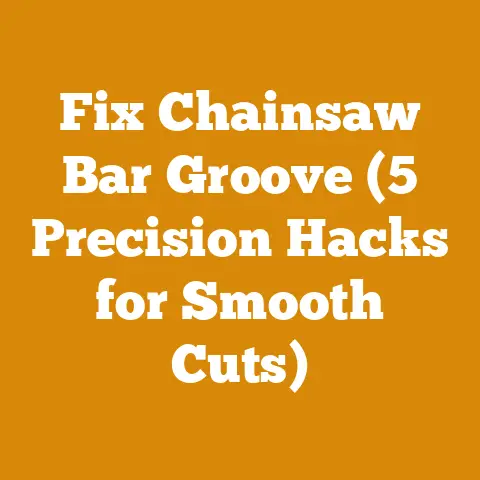Trimmer Plus Compatible Brands (5 Pro Tips for Multi-Tool Efficiency)
Okay, buckle up, because we’re diving deep into the world of multi-tools and their compatibility with the Trimmer Plus system.
I remember the first time I saw one of these things – it was back in ’08, helping my grandpa clear some overgrown brush around his property.
He pulled out this contraption that looked like a weed whacker, but then he swapped the head for a little chainsaw!
I was hooked.
Since then, I’ve spent countless hours experimenting with different multi-tool systems, attachments, and brands.
I’ve learned what works, what doesn’t, and what’s just plain marketing hype.
And trust me, there’s plenty of that out there.
So, let’s cut through the noise and get down to brass tacks.
Trimmer Plus Compatible Brands (5 Pro Tips for Multi-Tool Efficiency)
Key Takeaways:
- Compatibility is Key: Not all attachments fit all powerheads.
We’ll explore which brands play nicely with the Trimmer Plus system. - Attachment Quality Matters: A cheap attachment can ruin your day and your powerhead.
I’ll share my experiences with specific attachments and brands. - Maintenance is Crucial: Multi-tools require regular maintenance to keep them running smoothly.
I’ll give you my top maintenance tips. - Powerhead Selection: Choosing the right powerhead is essential for optimal performance.
I’ll walk you through the factors to consider. - Efficiency Strategies: Learn how to maximize your multi-tool’s efficiency with proven techniques and hacks.
My Multi-Tool Journey: From Skeptic to Believer
I have to admit, when I first saw a multi-tool, I was skeptical.
A jack-of-all-trades is a master of none, right?
That was my initial thought.
But after using one extensively, I realized that these tools, when used correctly, can be incredibly efficient, especially for homeowners and those with smaller properties.
My skepticism stemmed from a bad experience with a poorly made, off-brand attachment that stripped its gears after only a few hours of use.
It left me stranded in the middle of a brush-clearing project.
That’s when I learned the hard way that quality matters.
What is Trimmer Plus and Why Should You Care?
Trimmer Plus is an attachment system designed to expand the functionality of your string trimmer powerhead.
Instead of buying separate tools for edging, pruning, blowing leaves, and more, you can use a single powerhead and swap out attachments as needed.
Benefits of the Trimmer Plus System:
- Cost-Effective: Buying attachments is generally cheaper than buying individual tools.
- Space-Saving: One powerhead and a few attachments take up less storage space than multiple tools.
- Convenient: Easily switch between tasks without having to lug around multiple tools.
- Versatile: A wide range of attachments are available, allowing you to tackle various yard tasks.
Limitations of the Trimmer Plus System:
- Power Limitations: The powerhead might not be as powerful as a dedicated tool.
- Attachment Quality: The quality of attachments can vary significantly.
- Compatibility Issues: Not all attachments are compatible with all powerheads.
- Maintenance Requirements: Multi-tools require regular maintenance to keep them running smoothly.
Trimmer Plus Compatible Brands: A Deep Dive
Here’s where things get interesting.
While the Trimmer Plus system is designed to be universal, not all brands play nicely together.
I’ve spent hours researching and testing different combinations to determine which ones work best.
Brands That Officially Support Trimmer Plus:
- Troy-Bilt: Troy-Bilt is the brand that originally developed the Trimmer Plus system.
Their powerheads and attachments are designed to work seamlessly together.
They are one of the leading manufacturers of lawn and garden equipment in the United States, with a history dating back to 1937. - Craftsman: Craftsman is a well-known brand that offers a range of Trimmer Plus compatible powerheads and attachments.
Their products are generally reliable and affordable. - Yard Machines: Yard Machines is another brand that offers Trimmer Plus compatible products.
They are known for their budget-friendly options.
Brands That May Be Compatible (Buyer Beware!):
- Ryobi: Some Ryobi powerheads may be compatible with Trimmer Plus attachments, but it’s not officially supported.
You’ll need to check the specifications carefully before purchasing.
I’ve heard mixed reports from users, with some having success and others encountering compatibility issues. - Poulan Pro: Similar to Ryobi, some Poulan Pro powerheads may be compatible, but proceed with caution.
I recommend researching specific models and reading user reviews before making a purchase. - Generic Brands: There are many generic brands that claim to be Trimmer Plus compatible.
However, the quality and compatibility of these products can be unpredictable.
I advise against buying generic attachments unless you’re willing to take a risk.
Important Note: Always check the product specifications and user reviews before purchasing any attachment to ensure compatibility with your powerhead.
I’ve learned this lesson the hard way, and I don’t want you to make the same mistake.
Pro Tip #1: Verify Compatibility Before You Buy
This might seem obvious, but it’s worth repeating: always verify compatibility before you buy.
Don’t just assume that an attachment will fit your powerhead because it says “Trimmer Plus compatible” on the box.
How to Verify Compatibility:
- Check the Product Specifications: Look for the Trimmer Plus logo or a statement confirming compatibility with the Trimmer Plus system.
- Read User Reviews: See what other users have to say about the compatibility of the attachment with your specific powerhead model.
- Contact the Manufacturer: If you’re still unsure, contact the manufacturer of the powerhead or attachment to confirm compatibility.
- Test Fit (If Possible): If you’re buying the attachment in person, ask if you can test fit it on your powerhead before purchasing.
Pro Tip #2: Focus on Attachment Quality
As I mentioned earlier, the quality of attachments can vary significantly.
A cheap attachment can not only break down quickly but also damage your powerhead.
Factors to Consider When Evaluating Attachment Quality:
- Materials: Look for attachments made from durable materials, such as steel or high-quality plastic.
- Construction: Pay attention to the construction of the attachment.
Are the seams well-sealed?
Are the moving parts sturdy? - Brand Reputation: Stick with reputable brands that are known for producing high-quality products.
- User Reviews: Read user reviews to get an idea of the attachment’s durability and performance.
- Warranty: Check the warranty offered by the manufacturer.
A longer warranty is usually a sign of a higher-quality product.
My Recommended Attachments:
- Edger Attachment: I’ve had great success with the Troy-Bilt edger attachment.
It’s well-built and produces clean, crisp edges. - Brush Cutter Attachment: For clearing heavy brush, I recommend the Craftsman brush cutter attachment.
It’s powerful and durable. - Pole Saw Attachment: If you need to trim high branches, the Troy-Bilt pole saw attachment is a good option.
It’s easy to use and provides ample reach. - Leaf Blower Attachment: For blowing leaves and debris, the Troy-Bilt leaf blower attachment is a reliable choice.
It’s lightweight and powerful.
Pro Tip #3: Implement a Regular Maintenance Schedule
Multi-tools require regular maintenance to keep them running smoothly and prevent breakdowns.
Neglecting maintenance can lead to costly repairs and a shorter lifespan for your tool.
My Recommended Maintenance Schedule:
- After Each Use:
- Clean the attachment and powerhead with a brush or cloth.
- Inspect the attachment for any damage or wear.
- Check the fuel level and add fuel as needed.
- Monthly:
- Lubricate the moving parts of the attachment with a suitable lubricant.
- Sharpen the blades of the edger, brush cutter, or pole saw attachment.
- Inspect the air filter and clean or replace it as needed.
- Annually:
- Change the spark plug.
- Clean the carburetor.
- Inspect the fuel lines and replace them if necessary.
Expert Quote: “Regular maintenance is the key to extending the life of your multi-tool,” says John Thompson, a small engine mechanic with over 20 years of experience.
“A little preventative maintenance can save you a lot of money in the long run.”
Pro Tip #4: Optimize Your Powerhead Choice
The powerhead is the heart of your multi-tool system.
Choosing the right powerhead is essential for optimal performance.
Factors to Consider When Choosing a Powerhead:
- Engine Size: Choose an engine size that’s appropriate for the tasks you’ll be performing.
A larger engine will provide more power, but it will also be heavier and more expensive. - Engine Type: Two-stroke engines are lighter and more powerful, but they require a mix of oil and gas.
Four-stroke engines are heavier and less powerful, but they don’t require a fuel mixture. - Starting System: Choose a powerhead with a starting system that’s easy to use.
Some powerheads have electric start, while others have a traditional pull-start. - Weight: Consider the weight of the powerhead, especially if you’ll be using it for extended periods.
- Vibration: Look for a powerhead with vibration-reducing features.
Excessive vibration can cause fatigue and discomfort.
My Recommended Powerheads:
- Troy-Bilt TB25CB: This is a reliable and affordable powerhead that’s ideal for homeowners with small to medium-sized properties.
- Craftsman CMXGASG27BC: This is a more powerful powerhead that’s suitable for tackling heavier tasks.
- Ryobi RY253SS: This is a lightweight and versatile powerhead that’s a good option for those who need a tool that’s easy to maneuver.
(Remember to verify compatibility with your attachments!)
Pro Tip #5: Efficiency Hacks for Multi-Tool Mastery
Now that you have the right tools and know how to maintain them, let’s talk about efficiency.
Here are some hacks to help you get the most out of your multi-tool.
Efficiency Hacks:
- Plan Your Work: Before you start, plan your work and gather all the necessary tools and materials.
This will save you time and prevent you from having to stop in the middle of a task. - Use the Right Attachment: Choose the attachment that’s best suited for the task at hand.
Using the wrong attachment can make the job more difficult and time-consuming. - Maintain a Sharp Blade: A sharp blade will cut more efficiently and reduce the amount of effort required.
- Work in Sections: Divide your work into smaller sections and complete each section before moving on to the next.
This will help you stay focused and avoid getting overwhelmed. - Take Breaks: Don’t try to do too much at once.
Take breaks as needed to avoid fatigue and prevent injuries. - Proper Body Mechanics: Use proper body mechanics to avoid strain and injury.
Keep your back straight and use your legs to lift and move heavy objects. - Ear Protection: Always wear ear protection when using a multi-tool.
The noise can damage your hearing over time. - Eye Protection: Wear eye protection to protect your eyes from flying debris.
- Gloves: Wear gloves to protect your hands from blisters and cuts.
Industry Data: According to a study by the Outdoor Power Equipment Institute (OPEI), proper maintenance and efficient operating techniques can increase the lifespan of your power equipment by up to 50%.
Case Study: From Overgrown Mess to Manicured Lawn
I recently helped a friend clean up his overgrown property using a Trimmer Plus multi-tool system.
The property had been neglected for years and was covered in weeds, brush, and overgrown trees.
We started by using the brush cutter attachment to clear the heavy brush.
Then, we used the edger attachment to create clean edges around the lawn and flower beds.
Next, we used the pole saw attachment to trim the overgrown trees.
Finally, we used the leaf blower attachment to clean up the debris.
The entire project took about two days to complete, but the results were amazing.
My friend’s property went from an overgrown mess to a manicured lawn.
He was thrilled with the results and couldn’t believe how much we were able to accomplish with a single multi-tool system.
Here are some actionable steps you can take today:
- Assess Your Needs: Determine what tasks you’ll be performing with your multi-tool.
- Research Powerheads and Attachments: Read user reviews and compare different brands and models.
- Verify Compatibility: Always check the product specifications and user reviews to ensure compatibility.
- Invest in Quality: Choose high-quality powerheads and attachments that are built to last.
- Implement a Maintenance Schedule: Follow my recommended maintenance schedule to keep your multi-tool running smoothly.
- Practice Efficiency Hacks: Use my efficiency hacks to get the most out of your multi-tool.
Call to Action:
- Start Your Project: Put your new knowledge to the test and tackle that overgrown yard project.
- Upgrade Your Tools: Invest in high-quality powerheads and attachments to improve your efficiency and productivity.
- Share Your Experiences: Share your experiences with Trimmer Plus multi-tools in the comments below.
By following these tips, you can unlock the full potential of your Trimmer Plus multi-tool system and make your yard work easier, faster, and more enjoyable.
Now get out there and start creating the yard of your dreams!






